Audubon birders in Nome, Alaska
By Carol and Steve Lombardi
If you’ve only seen Nome as the snow-covered finish line for the Iditarod, well — as Madeline Kahn sang, “You’d be surprised…”
At about 9 p.m. on a June evening, we stepped down from our third aircraft of the day into the pleasantly brisk Nome twilight. Green grass bordered the airfield, interrupted by small patches of snow. A short drive around the city and harbor started our trip list with Red-Throated Loon, Red-Necked Grebe, Long-Tailed Jaeger, Slaty-Backed Gull, Common Redpoll, Red-Necked Phalarope, and — in someone’s backyard — a few musk oxen. Our modest motel was located at the Iditarod finish line on the shore of the Norton Sound, which was smooth as glass.
We were in Nome on a birding trip sponsored by Golden Gate Bird Alliance. Our guide, Rich Cimino of Yellowbilled Tours, uses the extended daylight of “the land of the midnight sun” to provide an intense three-day birding experience. The birds are active both day and “night,” and so were we. We saw about 90 species and got 15 life birds.
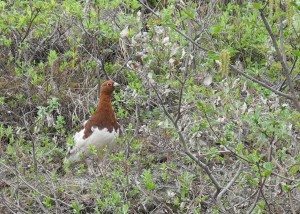
For a couple of Bay Area birders like ourselves who are used to seeing shorebirds on the shore, it seemed odd to see shorebirds nesting well inland in shrubs (Western Sandpiper) or on an airstrip (Ruddy Turnstone).
Nome is a frontier town built to survive the winter: It’s a mere 100 miles south of the Arctic Circle. Structures have few windows — they’re inefficient in the cold — and the tallest building is the new four-story hospital.
Because you must fly or barge everything in or out of Nome (there are no roads connecting to the outside world), the environmentalist comment that you never really throw anything away is vividly illustrated here. Industrial trash — trucks, buildings, machinery — stays where it stopped. And with a year-round population of only 3,700, it’s not hard to get out into nature. The “suburbs” are a 15-minute drive from the main street of the town.

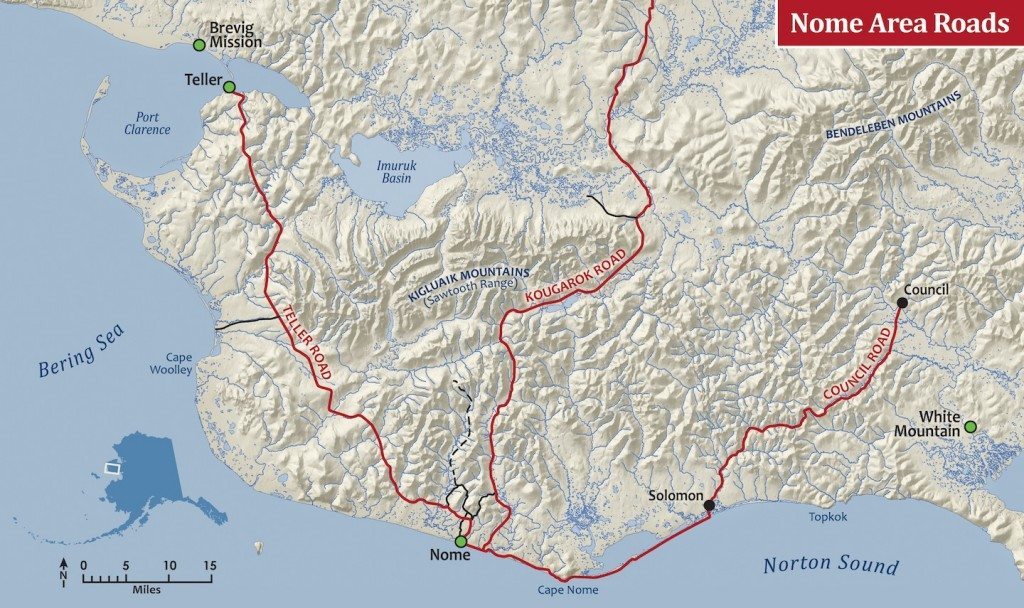
On Day 1 we drove southeast along Council Road in a warm, comfy pickup. The drive started along the beach and lagoons—finding Brant and Cackling Goose, Common Eider and Harlequin Duck, Lapland Longspur, Black-Legged Kittiwakes, Arctic Tern, Red-Throated Loon, and Yellow Wagtail.
We then turned inland through mountains and spruce forest, which produced Merlin, Arctic Warbler, Gray-Cheeked Thrush, and a nest full of Golden Eagle chicks. We were delighted to see Long-Tailed Ducks swimming in the boisterous mountain streams. Mew Gulls were nesting on the sandbars in the same streams (including one nest where we watched a fox steal a chick).
The days are about 20 hours long in June, which gave us plenty of time for birding. That first day was typical: We ate a quick breakfast in town and then headed into the field in Rich’s large crew-cab pickup. We spent the day birding out and back on Council Road, got back to town in time to eat dinner, and hit the hay with visions of warblers dancing in our heads.
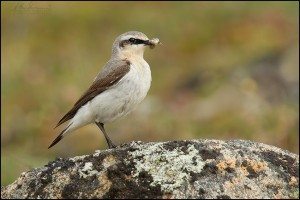
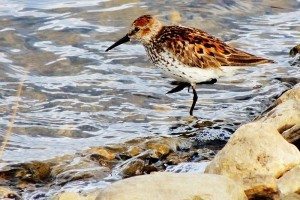
Day 2 took us inland on Kougarok Road. The neighborhood of Nome’s town dump hosted Slaty-Backed Gull. Nearby we saw Northern Shrike, Short-Eared Owl, Gray-Cheeked Thrush, and Yellow Warbler. The short, scrubby vegetation made it easier to survey hillsides and spot Parasitic Jaeger and Willow Ptarmigan. Long-Tailed Jaeger were common, perched on small mounds virtually everywhere.
Stops along the river brought us Wilson’s Snipe, Pipit, Northern Waterthrush, Yellow Warbler, a pair of Blackpoll Warblers (guarding a nest full of chicks), Common Redpoll, American Tree Sparrow, and a quick glance at a vociferous Bluethroat. Near the Quartz Creek Airport, we found Ruddy Turnstones. A determined walk across a rocky hillside netted a shy Wheatear. On the way home, we were treated to a look at a pair of Gyrfalcons standing guard over their cliffside nest.
Multiple times, we’d stop the truck to track a bird glimpsed on the roadside. Everyone had “Hold it!” privileges. We had several field guides to consult, and our small group could chase, wait, and debate as long as we wanted. This resulted in a supportive, self-paced effort every day — and our persistence was often rewarded with memorable lifer sightings.
The countryside around Nome consists mainly of rolling hills covered with short tundra vegetation and dwarf trees on top of permafrost. The scenery looks bleak at first glance. But the tundra in June is a miniature mosaic of color and texture when you look at it closely. Some lofty, snow-covered mountain ranges sit a few miles outside of Nome, as do forests of spruce. Streams emerge from the melt of blue-green snowdrifts.
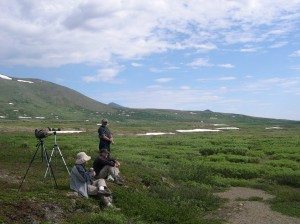
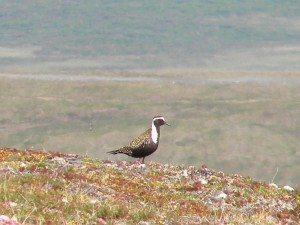
On Day 3 we took the long drive out Teller Highway. Just outside of Nome, we found American Golden Plover and Pacific Golden Plover. Fog limited our viewing for part of the morning, but we managed to spot Willow Ptarmigan, Rough-Legged Hawk, and Whimbrel. The wind in Teller was brutal, but Pelagic Cormorants and Black-Legged kittiwakes weren’t deterred. Returning to Nome, we found a Pacific Loon in a local pond and another Northern Shrike hanging around the cemetery.
We celebrated that night at Airport Pizza and decamped the next day for Anchorage and three days on our own exploring the Kenai peninsula, where our best bird was a Three-toed Woodpecker (parents attending a nest). Then home to the lower 48. All in all, a great trip.
——————————
Golden Gate Bird Alliance and Yellowbilled Tours are co-sponsoring four trips to Nome in Summer 2013. For information on these and other travel opportunities with Golden Gate Bird Alliance, click here. To learn about Yellowbilled Tours and their Nome trips, click here. (Tell Rich you were referred by GGBA – he donates $150 to GGBA for each GGBA member who signs up.) The Nome Convention & Visitors Bureau offers some birding information, while the Alaska Department of Fish & Game publishes a good brochure on Nome wildlife.
———————————
Steve and Carol Lombardi are semi-retired and have been birding since the prior century. Steve is the current volunteer Field Trip Coordinator for Golden Gate Bird Alliance. Carol labors as designated cheerleader and spotter on field trips and, at home, a copy editor of textbooks and anything else she can get her hands on.
